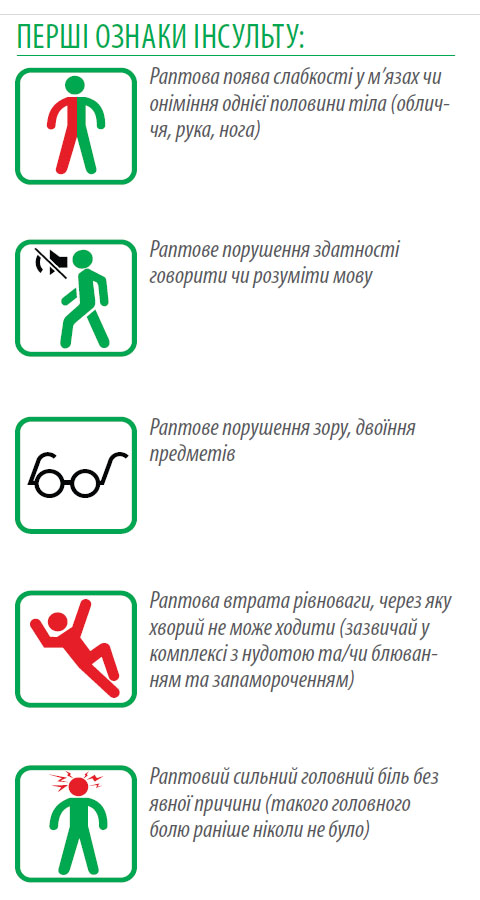Ischemic stroke - causes, symptoms and consequences
ADVANTAGES OF DIAGNOSTICS AND TREATMENT IN THE STROKE CENTER OF THE OBERIG CLINIC
- Leadership of the Oberig Stroke Center in Ukraine in terms of effectiveness of treatment and rehabilitation of patients who have survived a stroke: more than 80% regain the ability to self-care and do not depend on outside help in everyday life;
- The results of treatment at the Oberig Stroke Center are similar to the results of European centers for treatment and rehabilitation after a stroke;
- The Stroke Center operates on the basis of a multidisciplinary hospital, which provides patients with access to all necessary examinations (CT, MRI, X-ray, ultrasound, laboratory diagnostics);
- The Stroke Center team uses modern, effective and evidence-based methods of treatment and rehabilitation;
- Multidisciplinary approach: involving specialized specialists for the diagnosis and treatment of concomitant diseases. The Stroke Center team includes doctors (neurologists, neurosurgeons, anesthesiologists), rehabilitation specialists (physical therapists, occupational therapists, speech and language therapists) and qualified nurses.
- Rehabilitation begins in the first days after a stroke, which ensures maximum recovery of the brain and lost functions;
- The clinic makes every effort to ensure the patient's infectious safety, which reduces the risk of nosocomial infections;
- The Stroke Center determines the nutritional status of patients and provides appropriate nutrition taking into account the swallowing function (regular, enteral or parenteral);
- In patient care, middle and junior staff use technologies, equipment and consumables that prevent the development of infectious complications from the respiratory system (pneumonia) and pressure ulcers.
- Hospitalization in the Stroke Center is carried out around the clock, seven days a week. Experienced ambulance doctors of "Obereg" in case of a call to a patient with a stroke / suspected stroke, after determining the patient's condition, provide the necessary assistance on the spot and transport the patient by ambulance to the Stroke Center. Ambulances are equipped with everything necessary for the safe transportation of patients even in serious condition.
Get a consultation: call 044 521 30 03 Call an ambulance: 30 03
Stroke is a vascular catastrophe that occurs suddenly due to a violation of cerebral blood circulation. In the event of a stroke, a quick reaction of others is especially important, since every lost minute determines the patient's further life.
The cause of a stroke is a sudden violation of blood circulation in a part of the brain due to blockage or rupture of a vessel. Ischemic stroke is associated with blockage of a vessel, hemorrhagic stroke - with rupture of a cerebral artery. When a vessel blockage occurs, a certain area of the brain stops receiving enough blood and dies from lack of oxygen.
CAUSES OF ISCHEMIC STROKE
The first fatty deposits in the walls of our arteries appear at the age of about 10 years. Over time, these fatty masses increase, forming so-called plaques and "clogging" the vessels. This phenomenon is called atherosclerosis. The thicker the deposits become, the smaller the lumen of the artery becomes, which ensures blood flow to a certain area of the brain.

CAUSES OF ISCHEMIC STROKE
The first fatty deposits in the walls of our arteries appear at the age of about 10. Over time, these fatty masses increase, forming so-called plaques and “clogging” the vessels. This phenomenon is called atherosclerosis. The thicker the deposits become, the smaller the lumen of the artery becomes, which ensures the flow of blood to a certain area of the brain.
The following risk factors accelerate atherosclerosis: high blood pressure (arterial hypertension), consumption of large amounts of animal fats, overweight and a sedentary lifestyle, diabetes (especially with inadequate control of blood glucose levels). The activity of atherosclerosis and an increased risk of complications is indicated by a high level of cholesterol in the blood serum.
An atherosclerotic plaque can be damaged and rupture, and blood clots at the site of damage, forming a “clot” (thrombus), which can completely or partially close the artery to blood flow. In addition, the blood flow can tear off part of the thrombus that has formed on the surface of the plaque and carry it further until it blocks the lumen of a smaller vessel located in the brain.
In some cases (for example, in one of the variants of cardiac arrhythmia - atrial fibrillation), a thrombus forms in the heart and from there enters the brain, which leads to ischemic stroke.
SYMPTOMS OF ISCHEMIC STROKE
Threatening signs indicating the development of a stroke can occur suddenly and have various manifestations depending on the area of the brain affected. In the first minutes of stroke development, movements, sensitivity in the limbs and face, speech, vision, gait, etc. may be impaired.
However, among the manifestations there are those that are considered typical. Knowing the typical signs of an acute stroke allows you to quickly recognize this disease even for people without medical education and take the necessary measures to urgently take the patient to the hospital.
The first and most important sign of a stroke is the unexpected and rapid (within minutes or hours) appearance of neurological disorders.
- Weakness. Sudden weakness or numbness of half of the face, one arm or leg.
- Speech problems. Sudden inability to speak or understand speech.
- Vision impairment. Sudden visual impairment, including partial or complete loss of vision in one eye or double vision.
- Headache. Sudden and extremely severe headache.
- Unsteadiness. Sudden loss of balance and inability to walk without help (especially when combined with other symptoms).

CONSEQUENCES OF ISCHEMIC STROKE
A stroke causes brain damage, which leads to the sudden loss of certain functions that were provided by the affected part of the brain. The brain controls everything we do, feel, think or say, so damage to a part of the brain can have a variety of consequences: impaired movement, sensitivity, speech, mood or mental functions.
Just as no two people are exactly the same, no two stroke consequences are exactly the same. Each stroke has its own differences, but we can distinguish typical neurological disorders caused by a stroke:
- Muscle weakness or paralysis of half of the body (face, arm, leg);
- Sensory and/or perception disorders;
- Pain on the paralyzed side of the body;
- Visual disturbances (loss of part of the visual fields of one or both eyes, double vision);
- Aphasia – a disorder of speech and/or understanding the language of other people, as well as reading, writing and naming things;
- Fatigue;
- Pelvic organ dysfunction (urinary or fecal incontinence, urinary retention);
- Mood disorders and personality changes (anxiety, depression, aggression, apathy, attacks of unexplained crying or laughing);
- Memory, attention or thinking disorders;
- Impairment of consciousness (significant drowsiness, coma);
- Swallowing disorders.
If your loved one has had a stroke, do not delay, call the Stroke Center of the Universal Clinic "Oberig" by phone: (044) 521 30 03
Based on the materials of the manual "Stroke. Information for all concerned" (edited by Prof. M.E. Polishchuk)
To read «Ішемічний інсульт – діагностика, лікування та реабілітація»


